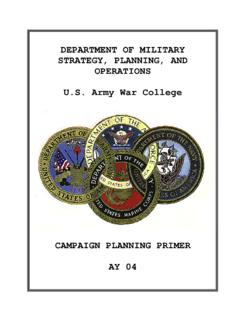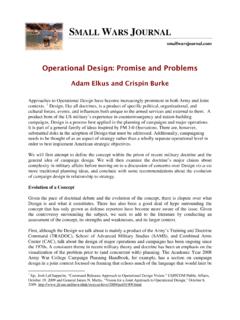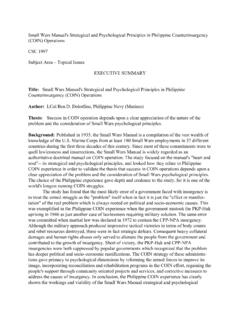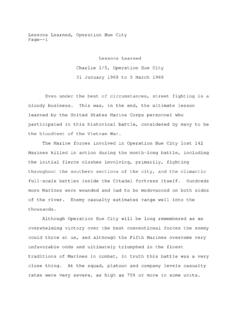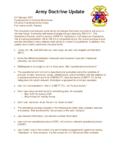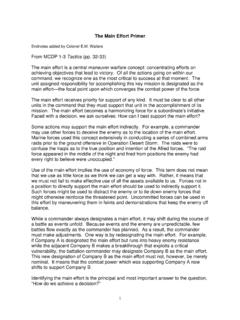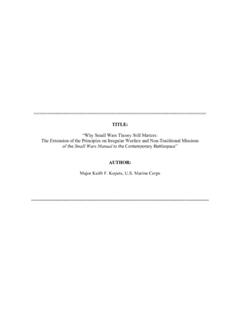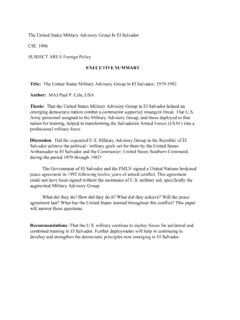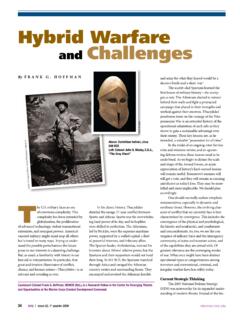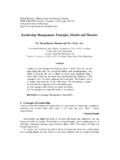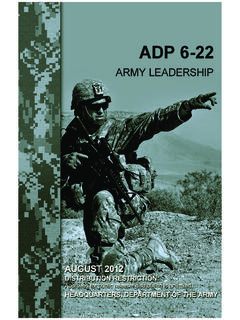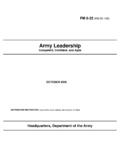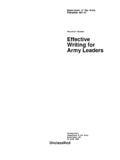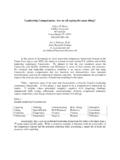Transcription of Army Doctrine Update CADD 200702 - smallwarsjournal.com
1 army Doctrine Update 24 February 2007 Combined Arms Doctrine Directorate US army Combined Arms Center Fort Leavenworth, Kansas This document summarizes some doctrinal changes that have occurred or will occur in the near future. It primarily addresses changes brought about by FMI , The Operations Process, and the version of FM 3-0, Operations: Full Spectrum Operations that is nearing completion. While FM 3-0 is not published yet, the review process is over and the information below reflects what will be in it when it is published. In addition, this Update covers some commonly misused terms: Terms UA, UE, and SUA are out. Use corps, division, and brigade combat team (BCT).
2 Know the difference between maneuver and movement (we don t maneuver networks; we move them). Battlespace is no longer a joint or army term. Use operational environment. The operational environment is described and evaluated using the variables of political, military, economic, social, infrastructure, and information with the addition of physical environment and time (PMESII-PT). Use the factors of METT-TC as the categories into which relevant information is grouped for a military operation. Use civil considerations (the C in METT-TC), not human terrain. Don t use colors as shorthand for something else, for example: o Red COP for enemy COP; o Blue forces for friendly forces.
3 Don t use red zone at all; the term is close combat. The operations process consists of the following activities: plan, prepare, execute, and assess. The shorthand for this process is the verb conduct. Use relevant information, not relevant combat information. Use common operational picture (COP), not common relevant operational picture (CROP). Use battle only in the context of a set of related engagements against an enemy. Operation is more inclusive. It is the correct term in almost all other contexts. army Doctrine Update #1 24 February 2007 2 Full spectrum operations is the name of the army s operational concept. The operational concept, portrayed in the figure below, is the foundation for all army Doctrine .
4 Note that civil support operations are only executed domestically and stability operations are only executed overseas. Components of full spectrum operations are offense, defense, stability, and civil support. Within full spectrum operations the tasks within each component are: o Offense: Movement to contact; Attack; Exploitation; Pursuit. o Defense: Area defense; Mobile defense; Retrograde. o Stability: Civil security; Civil control; Restore essential services; Support to governance; Support to economic and infrastructure development. o Civil support: Provide support in response to disaster; Support civil law enforcement; Provide other support as required.
5 army Doctrine Update #1 24 February 2007 3 Don t use stability operations and support operations (SOSO), stability and support operations (SASO), or stability, support, transition, and reconstruction operations (SSTRO). The correct term for this component of full spectrum operations is stability operations. (SSTRO is an interagency term; army forces conduct stability operations in support of SSTRO.) Use C2 system to designate a commander s command and control system. (Each commander has only one C2 system; see FM 6-0.) Use information systems to refer to the electronic equipment (such as radios and computers) that supports the exercise of command and control.
6 Do not use C4, C4I, or any of its variants at all in any contexts except as follows: Use C4 OPS cell to refer to the command post cell of that name (see FMI ). Economy of force is a role, not a task. Do not use kinetic and nonkinetic to describe operations, actions, activities, tasks, or targets. Use lethal and nonlethal. COCOM is a command authority. It is exclusive to a combatant commander. It is not the abbreviation for combatant commander or combatant command. The correct abbreviation for combatant commander is CCDR. Use geographic combatant commander (GCC), not regional combatant commander (RCC) or CINC. There is only one campaign in a joint operations area, the joint force commander s (JFC).
7 army headquarters and other Service forces don t do campaigns; the JFC does. There is not an air, land, maritime, space, or information campaign either. The army and/or joint force land component commander (JFLCC) do major operations, battles, and engagements. There are no more battlefield operational systems (BOS) or battlefield functional areas (BFA). These have been replaced with six warfighting functions. The warfighting functions, when combined with a seventh element, leadership, are the elements of combat power. The warfighting functions are: o Movement and maneuver o Fires o Intelligence o Sustainment o Command and control o Protection army Doctrine Update #1 24 February 2007 4 The chart below shows how the warfighting functions correspond to the joint functions and the Universal Joint Task List operational areas.
8 It also shows which army tactical tasks (from the army Universal Task List) are placed under each warfighting function. Don t use combat, combat support (CS) or combat service support (CSS) as categories for forces, functions, etc. Use the warfighting functions only. Maneuver support is not a warfighting function. A mission statement is not task, purpose, method and end state; it is who, what, when, where, and why. Do not use NBC; use CBRNE or CBRN based on the context and the threat. MACOM has been replaced by army command, army Service component command, or direct reporting unit, depending on the context. Use UAS (unmanned aircraft system), not UAV (unmanned aerial vehicle).
9 Effects Based Operations: See paragraph 1-32 in FMI For several years, the joint community has experimented with using effects to better link higher-level objectives to tactical actions. These efforts produced the EBO Concept. The proponent for EBO is the Joint Forces Command. EBO is designed to improve the planning, preparation, execution, and assessment activities of joint forces at the strategic and operational levels of war. However, EBO is not part of army Doctrine Update #1 24 February 2007 5 joint or army Doctrine . As defined by USJFCOM, it is not designed for use by army tactical forces. Bottom line, the army does not do EBO. The G-5/S-5 is no longer Civil Military Operations (CMO); it is now Plans.
10 The G-8 is now the Resource Manager. Staff estimate and running estimate are now combined in a single running estimate. Measure of performance (MOP) and measure of effectiveness (MOE) have replaced criteria of success. Situational awareness (SA) is a new term; within the cognitive hierarchy, SA is at the knowledge level (see FM 6-0, Appendix B). There is no position of effects coordinator and no staff element called effects cell. FMI retains the terms fire support coordinator and fire support cell in CPs. Operational themes are categories of mission types named in joint Doctrine . The operational themes are major combat operations, irregular warfare, peace operations, limited intervention, and peacetime military engagement.
